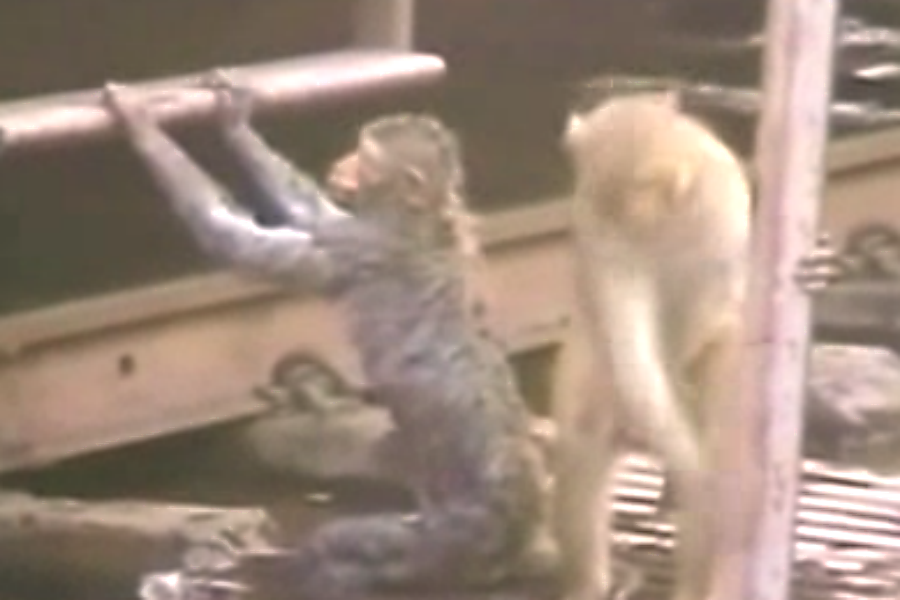Watch 'hero' monkey revive fallen monkey: A lesson for humans?
Loading...
Last week Pope Francis proclaimed that animals have souls and can go to heaven. Now, one monkey in Kanpur, India, has displayed the kind of compassion and heroics many humans might admire.
This monkey – probably a Rhesus macaque, the most common urban dweller in India – worked frantically to revive another monkey that had passed out on the train tracks after getting a severe shock while cavorting on an electric wire above the station.
Dozens of humans watched, took videos and snapped photos on Dec. 21, but none made a move to help as the doggedly determined little monkey shook, bit, slapped, and splashed water on the unconscious primate.
When his companion was finally revived, the two huddled together in a safe space between the tracks.
The video shows that once the injured monkey was revived, the rescuer continued to hold, rock, pet and support its injured companion while it regained its bearings.
While news of animal rescues aren’t entirely new, reports of one animal rescuing another have been fairly rare.
One famous case involved a Bottlenose dolphin, named Moko, whoh saved a mother pygmy sperm whale and her calf, who had beached themselves along the New Zealand coast back in March 13, 2008.
Rescuers were on the verge of giving up as the two whales kept beaching themselves and were in too much distress for their human helpers to be able to effect a rescue, according to The Telegraph.
Apparently, Moko, drawn by the distress cries of the whales, swam in and calmed the pair to the point where marine mammal stranding experts were able to get them off shore.
In other dolphin hero news, there was the case of the pod that saved a dog from drowning in a canal on Marco Island, Florida.
The unfortunate pooch had apparently fallen into the steeply concrete-walled canal system, unable to escape for 15 hours. The dolphins made so much noise they managed to attract the attention of a local resident who rescued the canine.
For those who want to cheer, check out the story of a herd of water buffalo that took on a pride of lions to rescue a baby buffalo that had been snatched from the herd. The poor calf had been initially caught by a crocodile, who lost his prey to a pride of lions. Then, an enthralling battle took place between the lions and the buffalo herd at a watering hole in South Africa's Kruger National Parki.
However, many animals are perhaps better known for their heroic acts rescuing humans from injury and in some cases, certain death.
One of the most famous example was a small Mongolian mare named Sgt Reckless who was once listed by Life Magazine as being among America’s top 100 heroes of all times for her heroic service during the Korean War in the 1950s.
According to a website dedicated to Reckless, during a five-day battle, “on one day alone she made 51 trips from the Ammunition Supply Point to the firing sites, 95% of the time by herself. She carried 386 rounds of ammunition (over 9,000 pounds – almost FIVE TONS! -- of ammunition), walked over 35 miles through open rice paddies and up steep mountains with enemy fire coming in at the rate of 500 rounds per minute.”
Reckless also acted as a shield for Marines pinned-down by gunfire, carried wounded soldiers down the mountain to safety and continued to re-supply the troops.
She was promoted to Staff Sergeant by the Commandant of the US Marine Corps.
Another animal who performed above and beyond the call of companion duty was a cat named Tara who, in May of this year, rescued a little boy from being attacked by a neighbor’s dog. The incident was caught on camera and uploaded to YouTube by the boy's father, Roger Triantafilo.
The boy was riding his bicycle in the driveway of his Bakersfield, Calif., home when he the dog went after the child, grabbing his leg and dragging him down the driveway, according to ABC affiliate KERO.
While scientists may debate the intelligence or compassion of various animal species. And, yes, humans are often tempted to anthropomorphize the behavior of animals – for better or worse. But these animals arguably did things that run counter to self-preservation instincts. And there's no doubt they've endeared themselves to the humans who observe and are inspired by their actions.








